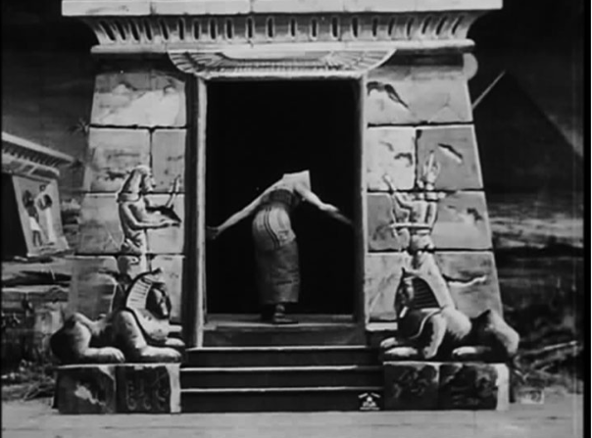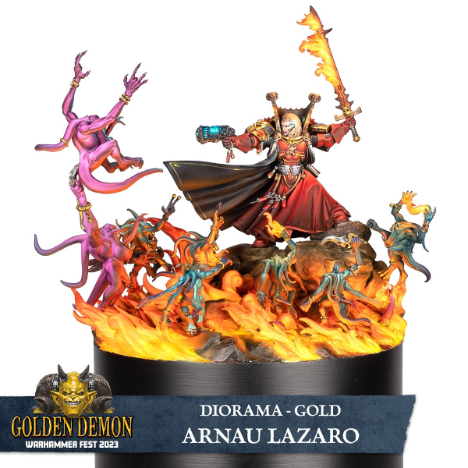Increasingly, story worlds of the 21st century are forged through intertextual narrative practices. From the branching texts of popular book and film franchises to the relationships between authorized and non-authorized texts (including fan fictions) that form alternative and/or contested sites for cross-media adaptation, these extended secondary worlds offer a fascinatingly complex avenue for multimodal storytelling. In the past, researchers like Marie-Laure Ryan, Karin Fast, and Henrik Örnebring have shown how the connections between films, novels, comic books, and video games can create transformative narrative links. However, there has been little academic attention on the role of external, tactile objects—like toys or miniatures—and how they function as narrative nodes in and of themselves. To showcase how physical objects intersect with the processes of narrative construction, I will use the plastic miniatures of the sci-fi tabletop wargame Warhammer 40,000 (or 40K, as I will abbreviate it) to consider how game pieces can represent a fictional world beyond themselves, even without the rules of the wargame as context. Although their function as game pieces in the 40K wargame may be their most prominent use, 40K miniatures are, at their core, a small statue—aesthetic objects. By combining statuary techniques with the application of paint or scenic terrain, the miniature’s aesthetic qualities encourage the viewer to use a process called closure to synthesize visual and narrative information with their imagination. Through closure, the frozen instant embodied by these miniatures acts almost like a photograph, or a single panel from a comic book: the miniature is one instant divested from the continuity of its own story world. As a result, the figure is akin the tableaux vivant of 19th century theatre—a “living picture” (Jacobs and Adriaensens 42) which uses still actors and theatrical scenery to suggest life and dynamism through their stillness.
The Unpainted Miniature and the Living Statue
At its most fundamental, a 40K miniature is a small, plastic statue. This is an important consideration, because the aesthetic form of a statue implies a curiously dichotomous sense of immobility and dynamism which hints at a life within the statue itself, waiting to be uncovered. In fact, Kenneth Gross’ The Dream of the Moving Statue discusses how the frozen form of a statue, despite its status as a “thing that stands still” (xi), synecdochally gestures towards a “peculiar life” (xiii)—and by extension toward the entire world that gave it motion—through its immobility. He explains that the statue signifies a kind of transformation, a “relic of a metamorphosis” (15) which has frozen the subject in time. Gross sees “in the statue […] a once-living thing whose life has been interrupted.” In its transformation to “stone or bronze or plaster”—or in this case, plastic—the form embodied by the statue is “[n]ot unlike Roland Barthes’s description of the photograph,” for both “[present] a body or a pose arrested in time” (15). Barthes discussion of the photograph’s arrested pose in Camera Lucida is quite applicable to the discussion of statues. Through Barthes’ emphasis on “the pose” (78), there is a suggestion that the photograph’s captured instant of immobility inherently implies the motion that led up to and continued after the captured moment. He explains that when looking at a picture, the immobility of the image draws his attention to “that instant, however brief, in which a real thing happened to be motionless,” in which “something has posed […] and has remained there forever” (78). There is a sense of continuity contained in the stilled pose. The dynamism in the pose is not derived from the gesture in and of itself, but rather from the understanding that the subject had been posed—the subject had a history which led up to its posing and continued on after the pose concluded. Barthes asserts that through the photograph’s stilled image, there is an attestation that the subject—and by extension the entire world bound up around the subject—“has indeed existed” (82).
Now, a photograph and a statue obviously differ because the statue lacks the “they were there” (82) that Barthes sees in a photo. A photo captures the real world, and by extension “the reality in a past state,” while a statue’s subject is “a memory, an imagination, a reconstitution” (82). However, while it is certainly true that a statue lacks a real past state, it still evokes a sense of had been posed and encourages the viewer to consider some kind of life—even a fictional one—that came to a halt. In this sense, a statue conveys a storytelling function; its frozen pose encourages the viewer to imagine the statue as a living entity that had a life in its own realm, and then to produce a story world in which the statue is animated. A statue’s immobility, and by extension, the immobility of a 40K miniature, allows the viewer to consider the miniature’s life within its story world. In fact, the dynamic posing and expressiveness of a typical 40K figure implies a certain narrative context, and gestures towards the figure’s “they were there”, even in its unpainted state. But how exactly is this possible? How can we gather anything substantive about a miniature’s “life” through the observation of this single fragment, divested from the larger whole?
Closure
Luckily, people are more than capable of meaning-making by filling the gaps between information. In fact, many artistic disciplines rely on this synthesis of fragments. For instance, in the context of graphic narratives, comic book academic Scott McCloud dubs this ability “closure.” According to McCloud, our senses can only provide a “fragmented and incomplete view” of the world, for “even the most widely travelled mind can only see so much of the world in the course of a life” (61). What he calls closure is the process by which we see “the parts” of our fragmented reality and use “past experience” to fill in the gaps—to “connect these moments and mentally construct a continuous, unified reality” (67). It is because of closure that we know people who have left the room still exist, countries we have never visited are real, and the past actually occurred. McCloud uses closure to explain how a comic book use “the gutter” (66)—the blank space between the panels—to suture the visual fragments together. However, this fundamental building block of graphic narratives can just as easily be used to describe the blank gaps between the “panels” of life—where “human imagination takes two separate images and transforms them into a single idea” (66).
Closure is a recurring process in a variety of artforms, including those that lack visuals entirely. The act of gap filling is even fundamental to our enjoyment of textual narratives—narration itself “is an art of the opening and closing of gaps” (Abbott 50), and when reading, the reader must cope “not only with what is left out of the narration but also what is given” (Abbott 45). This interplay between available information fragments and the blank space in between leaves room for “entire metaphysical universe[s]” to potentially exist. Within these narrative gaps “lie whole worlds that the art of narrative invites us either to actualize or leave as possibilities” (50). In a sense, narrative gaps afford the reader with a creative space in which they can synthesize fragmentary information and create entire worlds of meaning as they see fit.
Closure and 40K
Closure’s ability to unify fragmentary information in the space where “nothing is seen” (McCloud 67) is an incredibly useful analytical tool for my discussion of 40K miniatures because the process by which they “come to life” requires closure. Even if we ignore 40K’s lore and gameplay mechanics, the design of a typical 40K miniature implies a battlefield context through its posing and expressions alone. The viewer does not need to see the rest of the battlefield; closure will bring it to life in their heads.
For instance, Fig. 1 depicts a squad of stealthy Space Marines assassins known as Eliminators. If we ignore their paint job, their gameplay function, and even the lore of Warhammer 40K, what information can we glean about their extended lives and the story world they inhabit from their poses alone? Perhaps the most obvious thing that we can intuit from the posing of the Eliminators is their battlefield presence. Instead of idle or relaxed stances, these Space Marines suggests active engagement with the enemy. The figure in the back left of the unit aggressively points his rifle forward and braces his leg against a rock, as if to steady his aim. The pose implies a violent intent; if he is pointing his gun forward, it is likely he is aiming at someone, or at the very least searching for someone to fire upon. There is no muzzle flash, so the miniature has not captured the Space Marine mid-shot; however, because the muzzle flash is not present, perhaps the deadly shot is not far away. Closure may place the moment of firing sometime in the future.
Other figures in the squad are not engaged in combat, but their poses imply an active, continuous battlefield that existed before the current moment. For example, the figure in the rear right is reaching for the magazine at his hip. Through closure, the viewer can imply that his gun has no more ammunition and that he must reload it. In the same way that the aiming miniature’s pose places its killing shot sometime in the future, the time at which the reloading Marine ran out of bullets is placed in the past. Furthermore, these two figures not only extend their own fictional lives, but also those of their targets. The aiming figure conjures a future—he points his gun at an unknown target, who will be killed at any moment—while the reloading figure conjures a past through the suggestion of his spent ammunition and of the enemies he has slain. These two figures encompass a totality of past, present, and future—of the slain, and of those who the Marine have yet to slay.
In addition to past and future actions, closure also lets the viewer generate the temperament and personality of these miniatures. In particular, the sergeant in the front of the squad features a pose and expression which exudes a sense of tactical proficiency and a disdain for his squad’s targets. The way the sergeant keeps his fingers off the rifle’s trigger contributes to the squad’s sense of battlefield competence. He is not a crazed, gun-toting maniac, but a well-trained operator with a measured temperament and an understanding of safe firearm practices. However, he may not be as collected as he appears. As he looks downrange through his scope, his sneering expression—with eyes squinting and teeth barred—implies a degree of contempt for his targets that cuts through his ordinarily composed demeanor. This is not an expression of exertion, for the sergeant sports the most relaxed pose of the three; his expression can be read as one of sheer hatred. From intricate details such as these, questions about this squad’s extended life begin taking shape. How did these Space Marines acquire such tactical proficiency? Who is it they are firing at that could inspire such hatred, and where did it originate? From a miniature’s pose and design, an entire fictional life takes form because the mini synecdochally gestures towards the entire world that gave it motion. This process of worldbuilding requires closure to function.
The Tableau Vivant
40K miniatures are far more than their plastic poses alone. This is because hobbyists almost always paint their miniatures after purchasing them. In fact, the identity of 40K is so distinctly informed by miniature painting that it is considered essential to the hobby. For instance, Games Workshop sells an entire range of specialty miniature paints and equipment (“Painting and Modelling”) to assist hobbyists of all skill levels. However, perhaps the most important boon that paint provides for a miniature is another layer of information through which closure can occur. Paint schemes, weathering, and advanced techniques like environmental lighting and scenic bases further enhance the viewer’s ability to draw closure by placing the miniature within a visually mediated context. I will explore how the addition of environmental context intersects with the miniature’s stillness in a similar fashion to the tableau vivant of 19th century theatre, as both mesh stillness with dynamism to interrogate the vitality implied by the statue’s form.
According to Steven Jacobs and Vito Adriaensens, early cinema “[seemed] to have been fascinated by stasis and stillness” and featured sequences “in which moving people interact[ed] with static painting and sculptures.” In fact, the earliest films “continued a form of popular entertainment that combined the art of the theatre with those of early painting and sculpture”; this is the “tableau vivant, or living picture.” The tableau vivant is important to our discussion of 40K miniatures because this theatrical artform interrogates and “[emphasizes] the dialectic between movement and immobility” to create living statues.
On both the stage and the silver screen, the tableau vivant was a “theatrically lit composition […] of living human bodies that do not move throughout the duration of the display” (42). These compositions would intentionally freeze the action “at a point of heightened meaning” to use stasis of “the actor’s gestures” to assist in “expressing the full significance and implications of the story” being told on stage. The painterly and statuary qualities of these poses were further enhanced through stagecraft and special effects. Film directors like the legendary George Méliès, for example, would place cardboard backdrops behind the frozen actors to situate them in other settings, like the Middle Ages, vaguely “Greco-Roman style[s]” (52), or even fantasy settings (Fig. 2) like “a medieval wizard’s lair” (50).
By taking living actors and transforming them into statues, the tableau vivant served two aims. First, they literalize Kenneth Gross’ notion of the statue’s extended life by quite literally arresting the motion of living human bodies, thereby simulating a statue’s frozen moment while allowing the audience to witness the time before and after the freeze. Furthermore, the backdrops and other scenery generated a heightened degree of narrativity by placing the statues within an identifiable spatial context. When the frozen actors were placed inside a wizard’s tower, a famous painting, or dropped into an historical set piece, the viewer had access to another element through which they could draw closure; the three dimensionality of the actors and their frozen dynamism meshed with the setting built up around them to create a story world borne of the empty physical and temporal space around the frozen actors. The act of elaborately painting and basing 40K miniatures heightens the narrative potential of the minis in the same way that the elaborate stagecraft of the tableau vivant creates new narrative contexts for its frozen actors.
Golden Demon and Painted Narrativity
To illustrate the narrative power of the minipainting artform, it would be remiss to ignore the sheer artistic splendor of the pieces produced for Games Workshop’s annual Golden Demon minipainting competition, “one of the world’s largest and longest running miniature painting competitions on the planet.” Painters from around the world submit pieces to “12 distinct categories, ranging from single miniatures to units and large battle scenes” and compete to win “the coveted Slayer Sword”. As “a true celebration of miniature painting at the highest levels” (Golden Demon 2), the works displayed at Golden Demon highlight the 40K miniature’s capacity for visual storytelling at its most proficient. This is because a winning Golden Demon piece “isn’t just about technical prowess”, but also entails using the minipainting medium to create a compelling “atmosphere” and “narrative” that “fits in to Games Workshop’s different worlds and universes” (6). Without leveraging the artform’s capacity to represent compelling narrative contexts and gesture towards a larger world, a painter cannot hope to win at this level.
Golden Demon winners use a litany of intricate artistic techniques to build a narrative space around their piece. First, the paint applied to the miniature itself goes a long way to expressing the miniature’s extended life. The most immediate narrative detail conveyed through a paintjob is the figure’s faction colors. Different Space Marine factions—or Chapters—feature diverse backgrounds, battlefield tactics, and temperaments which come through in their wildly varied color schemes (“Faction Focus”). The choice to paint one’s Marines as crimson Blood Angels instead of blue Ultramarines conjures different mental images in the imagination of a lore-savvy viewer. Furthermore, color schemes are largely skill-independent. Games Workshop offers a paint technique called Battle Ready, which refers to the simplest paint job a miniature requires from the company to be considered “ready to game with” (“Introducing: Battle Ready”). Even the newest painters can convey the narrativity behind a figure’s faction colors.
Other advanced techniques, like simulated lighting and textural detail, further modify the miniature’s storytelling capacity. These advanced techniques all contribute to enhancing the miniature’s extended life by adding a credible, totalizing sense of atmosphere to the piece, which thereby increases the information a viewer can suture together through closure. To highlight the wide emotional breadth that a miniature’s paint can convey, I will analyze a diorama of a heroic sunset duel by minipainter Victor Vera (Fig. 3), which won silver in the Duel category at Golden Demon Adepticon 2023.
The way Vera renders light on materials like metal, leather and skin all afford opportunities to express different emotions and plot details through environmental storytelling. In the Vera piece, a Space Marine and an Ork do battle in a rocky desert environment; the sword-wielding Space Marine, decked out in polished power armour, lands the killing blow on an Ork, who has clearly cobbled together his armour and weaponry from rusty scrap metal. The way Vera paints environmental lighting and texture on the figures’ forms affords the viewer with a lot of information in terms of the setting. For instance, the Vera piece uses warmer highlights across the entire miniature to place the battle firmly during golden hour, perhaps at sunset. When combined with the boulder the Ork rests upon, the viewer can immediately imagine the rest of the battlefield, both spatially and temporally.
Furthermore, the armor and weaponry of the dueling combatants also conveys aspects of their character. The Space Marine’s power armor is brightly reflective, and the only blemish on his power sword is the blood of the dying Ork. This Marine clearly takes pride in his war gear and keeps it pristine and well-maintained. By contrast, rust stains and scratches mar the Ork’s weaponry and armor; the Ork’s design suggests an unrefined, wanton savagery that the glimmering Marine does not. The way the environmental lighting interacts with the Marine’s armor also establishes a very particular mood. The setting sun reflecting off the armor and sword of the Marine as he vanquishes his foe conveys a sense of bright, energetic triumph as rays of golden light spill onto the noble victor. This is the story of a battle on a sun-lit desert, but it is also a story of heroic victory against a savage alien threat, where the proud nobility of the Marine vanquishes the mad anarchy of the Ork. The painting choices made by Vera express the rich story of these miniatures’ extended lives and the world they inhabit.
The lighting and textural work on a miniature is not the only way to convey an extended world. The terrain and basing around the miniature allow the viewer to construct a fully realized narrative in the same way that the painted backgrounds of the tableau vivant place their frozen actor-statues in a palpable setting. Many Golden Demon Winners like Vera simulate the lighting of the environment on the miniature itself through the use of “object source lighting,” which refers to “a light source on [a] miniature that may exist on the model, the base, or somewhere else to create a really dramatic lighting effect” (“Object Source Lighting”). In Vera’s case, the source of the golden light is coming from “out of frame”, so to say. The viewer cannot see the golden rays of the sun because there is not a literal source of light, nor is there a painted background that depicts a sunset, so the viewer must use closure to intuit the time of day. However, other miniatures create far more elaborate environments by including scenic details on the base of the miniature.
For instance, Fig. 4 depicts a Gold-winning diorama by Arnau Lazaro. The piece depicts Mephiston, a powerful Space Marine character, battling a horde of chaos demons. Lazaro wanted to communicate the fury of the battle by having Mephiston be in a fiery hellscape, but instead of simply intuiting this landscape through environmental lighting that is “offstage,” Lazaro sculpted physical flames beneath the miniature’s feet. The scale is far larger than the Vera piece, and the viewer can see the size of the hellish landscape Mephiston that must battle through. Lazaro’s piece is the miniature medium’s equivalent of on-stage pyrotechnics; flames quite literally surround the miniature, which makes the battle for survival all the more volcanic. Through his masterful use of sculpture and simulated light, a wasteland of seething, infernal carnage takes shape.
The process by which 40K miniatures can express the lives and worlds of the people and places they represent is a matter of gap-filling—of taking what is seen and using the imagination to intuit what is not depicted. Both painted and unpainted miniatures engage in this kind of closure. The unpainted miniature, as a plastic statue, implies kineticism beyond its frozen pose by gesturing towards spatial and temporal continuity, while the microdetails of the figure’s body language and expression unfolds the interiority of the statue’s character. Through its design and gesture alone, a living figure in a living world takes shape. The viewer can then supplement their viewing experience with painted and sculpted features to further assist in constructing a truly atmospheric environment. The texture and materials of the figure, the lighting surrounding it, and scenic details applied through basing techniques allow for a fully realized fictional setting, all contained in the palm of every player’s hand.
Appendix: Illustrations
Figure 1
“Eliminators.” Games Workshop, https://www.games-workshop.com/en-CA/Space-Marines-Primaris-Eliminators-2020.
Figure 2

Figure 3

Figure 4

Works Cited
Abbott, H. Potter. “Story, plot, and narration.” The Cambridge Companion to Narrative, edited by David Herman, Cambridge University Press, 2007, pp. 39-51.
Adriaensens, Vito, and Steven Jacobs. “The sculptor’s dream: Tableaux vivants and living statues in the films of Méliès and Saturn.” Early Popular Visual Culture, vol. 13, no. 1, Routledge, 2015, pp. 41-65.
Barthes, Roland. Camera Lucida: Reflections on Photography. Translated by Richard Howard, Hill and Wang, 1981.
Golden Demon: Adepticon 2023; Category List & Entry Guidelines. Games Workshop, 2022, https://www.warhammer-community.com/wp-content/uploads/2023/02/szYliMlYWxfFbwQF.pdf.
Gross, Kenneth. The Dream of the Moving Statue. Cornell University Press, 1992.
“Introducing: Battle Ready.” Warhammer Community, 21 May. 2019, https://www.warhammer-community.com/2019/05/21/introducing-battle-readygw-homepage-post-1fw-homepage-post-1/.
McCloud, Scott. Understanding Comics: The Invisible Art. HarperCollins Publishers, 1993.
“Object Source Lighting.” The Army Painter, https://www.thearmypainter.com/advanced-techniques/paint/object-source-lighting/#:~:text=Object%20source%20lighting%2C%20or%20OSL,even%20a%20 powerful%20 magic%20 sword!.
“Painting and Modelling.” Games Workshop, https://www.games-workshop.com/en-CA/Painting-Modelling
“Warhammer 40,000 Faction Focus: Space Marine Chapters.” Warhammer Community, 01 Jun. 2023, https://www.warhammer-community.com/2023/06/01/warhammer-40000-faction-focus-space-marine-chapters/.

Alexander Jacobi
Alexander Jacobi
Wilfrid Laurier University
he/him
Alexander Jacobi is a Doctoral Candidate at Wilfrid Laurier University’s English and Film PhD, with a specialization in Narratology, Game Studies, and New Media. Because of his love of public speaking and engaging education, he hopes to become an English or Cultural Studies professor after the conclusion of his program. He also channels his creativity and passion into miniature painting, drawing, creative writing, photography, Dungeons and Dragons, video games, and watching terrible movies.
Instagram – @alexanderjaci64
